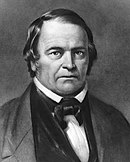Shut-door theology
This article has multiple issues. Please help improve it or discuss these issues on the talk page. (Learn how and when to remove these template messages)
|
| Part of a series on |
| Adventism |
|---|
 |
|
|
Shut-door theology was a belief held by the
History
After the
The largest group organized as the American Millennial Association, a portion of which was later known as the Evangelical Adventist Church. Unique among the Adventists, they believed in an eternal hell and consciousness in death. The Life and Advent Union was founded by George Storrs in the year of 1863. He had established The Bible Examiner in 1842. The Advent Christian Church officially formed in 1861. The Seventh-day Adventist Church officially formed in 1863, so they still were known as
When Jesus did not arrive the
The groundwork for the theory came from a William Miller quote published in the December 11, 1844
In January 1845, editors Apollos Hale of the Advent Herald and Joseph Turner of The Hope of Israel further developed this thought, eventually coming to believe that on October 22, 1844, every man's destiny was forever sealed, using Revelation 22:11,12 as their basis. The term "shut door" came from Jesus' parable of the Bridegroom and the Virgins: "and they that were ready went in with him to the marriage: and the door was shut." (Matthew 25:10) The Adventists believed that Jesus' return was imminent.
An early title the
Ellen White early on in her ministry supported the belief in the Shut door as most
In an 1849 vision, White heard Christ tell her that the door that had been shut was the door to the Holy Place of the Heavenly Sanctuary. However, many of the
Gradually, individuals who had no prior connection with Adventism converted to the church and by 1854, religious leaders and most Adventists were ready to accept that the shut-door theory was not correct understanding.
Later and recent commentary
Ellen White was later questioned over her beliefs, and whether she had received them in vision. She denied the latter, writing in 1874:
- "With my brethren and sisters, after the time passed in forty-four I did believe no more sinners would be converted. But I never had a vision that no more sinners would be converted."[1]
Graeme Bradford defends, "Some would argue that this teaching is an embarrassment to the Seventh-day Adventist Church today. Those who use such an argument should be reminded of the fact that a similar 'Shut Door teaching' was applied by early Christians (including Peter) for the first 10 years of the existence of the newly formed Christian Church. For the first 10 years they only preached to the Jews as being worthy of God's grace. That is the purpose of the vision given by God to Peter in Acts 10:9–34. All movements raised up by God still have the imperfections common to humanity."[4]
See also
- Adventism
- History of the Seventh-day Adventist Church
- Inspiration of Ellen White
- Seventh-day Adventist theology
References
- ISBN 0-8280-1430-2.
- Knight, George R. (2000). A Search for Identity: The Development of Seventh-day Adventist Beliefs. Hagerstown, MD: Review and Herald. ISBN 0-8280-1541-4.
- Schwarz, Richard W.; Greenleaf, Floyd (1979). Light Bearers: A History of the Seventh-day Adventist Church. Nampa, ID: ISBN 0-8163-1795-X.; p53–54
- ^ Letter 2, 1874. Ellen White to J. N. Loughborough from Battle Creek, Michigan in August 24, 1874. As reprinted in Selected Messages volume 1, page 74; chapter
- ^ Olson, "The 'Shut Door' Documents"
- ^ "Chapter 44: The Shut Door—A Case Study". www.whiteestate.org.
- ^ "prophet-14-Ellen White's spiritual growth". www.sdanet.org.
External links
Ellen G. White Estate website:
- "Open and Shut Door" from the Seventh-day Adventist Encyclopedia, second revised edition, 11:249–252
- "The 'Shut Door' Documents" compiled by Robert W. Olson, 1982
- Unusual statements of Ellen White
- Advent Experience by Review and Heraldarticles
- "The Shut Door—A Case Study", chapter 44 in Messenger of the Lord by Herbert E. Douglass
- F. D. Nichol, Ellen G. White and Her Critics: chapter 13, "A Sketch of Early Adventist History"; chapter 14, "The Shut-Door Charge Examined"; chapter 15, "Mrs. White Taught That Probation Still Lingers". See also "Appendix H: From Shut Door to Open Door"; and "Section 10: The Open and the Shut Door" from "Appendix J: Deleted Passages Examined"
